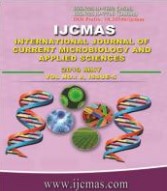


 National Academy of Agricultural Sciences (NAAS)
National Academy of Agricultural Sciences (NAAS)

|
PRINT ISSN : 2319-7692
Online ISSN : 2319-7706 Issues : 12 per year Publisher : Excellent Publishers Email : editorijcmas@gmail.com / submit@ijcmas.com Editor-in-chief: Dr.M.Prakash Index Copernicus ICV 2018: 95.39 NAAS RATING 2020: 5.38 |
No doubt the climatic aberrations will severely set back agricultural development in most of the tropical countries particularly India, where an increasing share of the poorest and most vulnerable population resides. Zonal Agricultural Research Station is located at Mandya district of Karnataka lies under agro-climatic zone 6 (Southern dry zone) having longitude of 76° 49.8' E and latitude of 12°34.3' N with 697 meters above mean sea level. Rainfall and temperature data of 28 years (1991-2018) obtained from Agromet observatory, Zonal Agricultural Research Station (ZARS), Mandya, University of Agricultural Sciences, Bengaluru was analysed for variability. The mean annual rainfall of the station is 735.9 mm distributes Pre-monsoon or summer (March-May) of 182.8 mm, south-west monsoon (June-September)of 313.4mm, north-east monsoon (October-December) of 235.4mm and winter season (January-March) of 4.2 mm. The trend indicated that the maximum contribution was from south west monsoon (42.59 %) and lowest during winter (0.57 %) whereas September was the rainiest month (130.66 mm). The standard deviation (SD) was highest (123.4) with Co-efficient of variation (CV) of 39.40 %, which indicates high variability and dependability on rainfall from S-W monsoon. The mean monthly maximum temperature was 34.2°C and mean monthly minimum temperature was 14.4°C. Mean annual maximum temperature was decreasing in a linear path contrastingly and mean minimum temperature was increasing linearly over the years. The annual rainfall variability indicates that 8 years received excess rainfall (21.6 to 57.5 %), 12 years had normal rainfall (-4.0 to 10.4 %),2 years with slight drought (-19.1 to -19.2 %) and 6 years of moderate drought (-29.3 to -42.6%) were recorded. Overall analysis of rainfall and temperature shows variation in distribution and amount of rainfall received.
 |
 |
 |
 |
 |